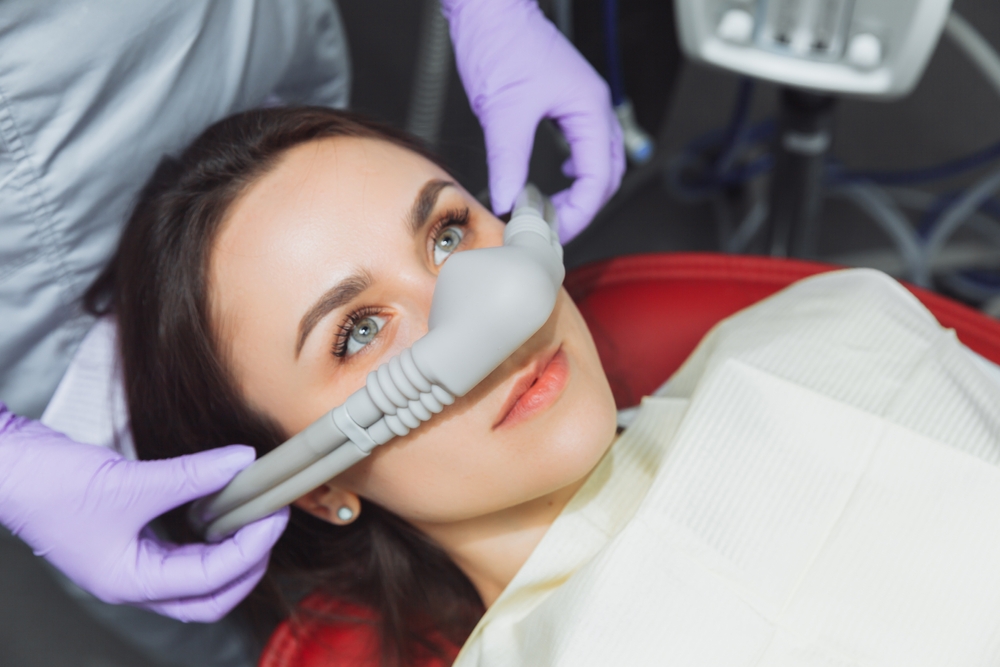
Office-Based Anesthesia

Safe & Comfortable Sedation for Dental Procedures
At Gramercy Dental Group, we understand that dental anxiety, fear, and discomfort can prevent patients from seeking the care they need. That’s why we offer office-based anesthesia, a safe and effective way to help patients relax during dental procedures. Our team is highly trained in administering different levels of anesthesia, ensuring a comfortable, stress-free experience while maintaining the highest standards of safety.
Whether you need a routine procedure or complex oral surgery, our sedation options allow us to tailor the experience to your comfort level, helping you receive the care you need without fear or discomfort.

What Is Office-Based Anesthesia?
Office-based anesthesia refers to the administration of sedation or general anesthesia in a dental office setting, eliminating the need for a hospital visit. This allows us to perform a wide range of procedures—including extractions, implants, root canals, and periodontal surgeries—in a controlled and comfortable environment.
We offer various levels of sedation, depending on your needs and medical history:
- Local Anesthesia – Numbs the treatment area but keeps you fully awake.
- Nitrous Oxide (Laughing Gas) – A mild sedative that helps you feel relaxed while remaining conscious.
- Oral Sedation – Medication taken before the procedure to induce deep relaxation.
- IV Sedation – A stronger, controlled sedative administered through an IV, often resulting in partial or full memory loss of the procedure.
- General Anesthesia – Puts you into a deep sleep, typically used for extensive surgeries or for patients with severe dental anxiety.
Who Can Benefit from Office-Based Anesthesia?
Many patients benefit from anesthesia and sedation options, including those who:
- Experience severe dental anxiety or phobia
- Have difficulty sitting still for long procedures
- Require extensive or multiple treatments in one visit
- Have a strong gag reflex that interferes with treatment
- Have special healthcare needs or difficulty understanding treatment
- Are undergoing complex procedures like wisdom tooth removal or dental implants
We carefully evaluate each patient’s medical history, current health status, and level of anxiety to determine the safest and most effective anesthesia option.
Types of Office-Based Anesthesia & Their Benefits
Local Anesthesia – Simple & Effective for Minor Procedures
How It Works: Local anesthetic (such as lidocaine) is injected directly into the treatment area to numb the nerves, ensuring a pain-free procedure.
- Ideal for fillings, crowns, root canals, and minor extractions
- No sedation—fully awake and aware
- Quick recovery, no lasting drowsiness
- Can be combined with nitrous oxide or oral sedation for added relaxation
Nitrous Oxide (Laughing Gas) – Mild Sedation for Relaxation
How It Works: A mask delivers a colorless, odorless gas, helping you feel lightheaded, relaxed, and even euphoric while remaining awake.
- Safe for both children and adults
- Quick onset and wears off within minutes
- No lingering drowsiness—safe to drive home after treatment
- Ideal for mild to moderate dental anxiety or minor procedures
Oral Sedation – A Deeper Level of Relaxation
How It Works: A prescribed sedative (such as Valium, Halcion, or Ativan) is taken before the procedure, making you feel drowsy and deeply relaxed.
- Perfect for moderate dental anxiety
- Can be combined with local anesthesia for pain-free treatment
- Patients often have little to no memory of the procedure
- Requires someone to drive you home after the appointment
IV Sedation – Twilight Sleep for a Stress-Free Experience
How It Works: Medication is administered through an intravenous (IV) line, allowing for controlled and adjustable sedation. Patients often enter a “twilight state,” where they are semi-conscious but relaxed, with little to no memory of the procedure.
- Great for extensive dental work or high anxiety
- Fast-acting and easily adjustable during treatment
- Minimal recollection of the procedure
- Monitored by a trained anesthesia team for safety
General Anesthesia – Full Sleep for Complex Procedures
How It Works: A combination of medications puts you into a deep sleep, ensuring you feel nothing and have no awareness during the procedure. General anesthesia is typically used for:
- Complex oral surgeries (e.g., multiple extractions, jaw surgery)
- Patients with severe dental phobia or special needs
- Long procedures requiring extensive work in a single visit
During general anesthesia, vital signs are carefully monitored by trained professionals, ensuring the highest level of safety throughout the procedure.


Safety & Monitoring During Anesthesia
At Gramercy Dental Group, your safety and comfort are our top priorities. We follow strict guidelines set by the American Dental Association (ADA) and the American Society of Anesthesiologists (ASA) for office-based anesthesia.
- Trained Anesthesia Team – Our dentists and staff are certified in sedation and emergency protocols.
- Advanced Monitoring Equipment – Heart rate, oxygen levels, and blood pressure are continuously tracked.
- Personalized Sedation Plans – We assess each patient’s medical history and tailor anesthesia options accordingly.
Before the procedure, we will discuss:
- Your medical history & current medications
- Pre-procedure fasting instructions (if needed)
- What to expect during and after the procedure

What to Expect After Anesthesia?
Recovery times vary depending on the type of sedation used. Here’s a general guide:
- Nitrous Oxide – Wears off within minutes; you can drive yourself home.
- Oral Sedation – Grogginess may last a few hours; a driver is required.
- IV Sedation & General Anesthesia – Recovery can take a few hours; a driver is required, and rest is recommended for the remainder of the day.
We provide detailed post-sedation instructions to ensure a smooth recovery. Most patients feel completely normal within 24 hours.
Why Choose Gramercy Dental Group for Office-Based Anesthesia?
- Experienced & Certified Team
- State-of-the-Art Safety & Monitoring
- Multiple Sedation Options for Every Patient’s Needs
- Compassionate & Comfortable Care
If you experience dental anxiety or need extensive treatment, office-based anesthesia can help make your visit stress-free and comfortable.
Call us today to learn more or schedule a consultation.
Why Choose Gramercy Dental Group for Office-Based Anesthesia?
- Experienced & Certified Team
- State-of-the-Art Safety & Monitoring
- Multiple Sedation Options for Every Patient’s Needs
- Compassionate & Comfortable Care
If you experience dental anxiety or need extensive treatment, office-based anesthesia can help make your visit stress-free and comfortable.
Call us today to learn more or schedule a consultation.
Frequently Asked Questions About Office-Based Anesthesia
Is office-based anesthesia safe?
Yes! Our practice follows strict safety protocols, and all patients are monitored closely throughout sedation.
How do I know which sedation option is right for me?
We assess your anxiety level, medical history, and procedure type to determine the best option for your comfort and safety.
Can I eat or drink before sedation?
- For nitrous oxide or local anesthesia: No fasting is required.
- For IV sedation or general anesthesia: You must avoid food and drink for at least 6-8 hours before your procedure.
Will I remember my procedure?
With IV sedation and general anesthesia, most patients have little to no memory of their treatment. Oral sedation may also cause mild amnesia.
How long does it take to recover?
Nitrous oxide wears off quickly, while oral, IV, and general anesthesia require a few hours to fully recover.
